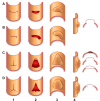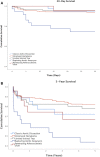Limited Aortic Intimal Tears: CT Imaging Features and Clinical Characteristics
- PMID: 36601454
- PMCID: PMC9806729
- DOI: 10.1148/ryct.220155
Limited Aortic Intimal Tears: CT Imaging Features and Clinical Characteristics
Abstract
Limited aortic intimal tear is an uncommon lesion of the dissection spectrum. The lesion has several imaging features that are not well known, including asymmetric aortic contour abnormalities, filling defects, and various morphologic patterns, such as linear, L-shaped, T-shaped, and stellate configurations. Hemorrhage of the aortic wall may also be present in patients with this rare entity. This imaging essay reviews the CT imaging findings and clinical characteristics of patients with limited intimal tears. Keywords: Aorta, CT © RSNA, 2022.
Keywords: Aorta; CT.
© 2022 by the Radiological Society of North America, Inc.
Conflict of interest statement
Disclosures of conflicts of interest: M.H.M No relevant relationships. V.L.T. Shareholder of Segmed. R.L.H. No relevant relationships. M.J.W. Postdoctoral fellowship grant from the American Heart Association. H.M. No relevant relationships. A.S.C. No relevant relationships. G.J.B. No relevant relationships. D.F. Deputy editor for Radiology: Cardiothoracic Imaging.
Figures









References
-
- Murray CA , Edwards JE . Spontaneous laceration of ascending aorta . Circulation 1973. ; 47 ( 4 ): 848 – 858 . - PubMed
-
- Widder DJ , Novelline RA , Derkac WM . Spontaneous nontraumatic rupture of the thoracic aorta . J Thorac Cardiovasc Surg 1983. ; 86 ( 4 ): 626 – 628 . - PubMed
-
- Padró JM , Caralps JM , García J , Arís A . Spontaneous rupture of the ascending aorta . J Cardiovasc Surg (Torino) 1988. ; 29 ( 1 ): 109 – 110 . - PubMed
-
- Aoyagi S , Akashi H , Fujino T , et al. . Spontaneous rupture of the ascending aorta . Eur J Cardiothorac Surg 1991. ; 5 ( 12 ): 660 – 662 . - PubMed
-
- Handa N , Takamoto S , Hatanaka M , et al. . Spontaneous non-traumatic rupture of the thoracic aorta . Thorac Cardiovasc Surg 1994. ; 42 ( 6 ): 355 – 357 . - PubMed

